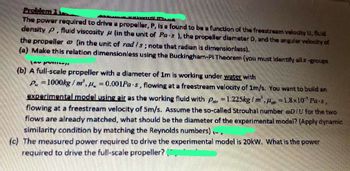
Elements Of Electromagnetics
7th Edition
ISBN: 9780190698614
Author: Sadiku, Matthew N. O.
Publisher: Oxford University Press
expand_more
expand_more
format_list_bulleted
Question
Hhhhhhhh hiiii aappppp

Transcribed Image Text:Problem
The power required to drive a propeller, P, is a found to be a function of the freestream velocity U, fluid
density P, fluid viscosity (in the unit of Pa-s), the propeller diameter D, and the angular velocity of
the propeller (in the unit of rad /s; note that radian is dimensionless).
(a) Make this relation dimensionless using the Buckingham-Pi Theorem (you must identify all z-groups
M
La punne
(b) A full-scale propeller with a diameter of 1m is working under water with
P=1000kg/m³, = 0.001Pa-s, flowing at a freestream velocity of 1m/s. You want to build an
experimental model using air as the working fluid with Par=1.225kg/m, 1.8x10 Pa-s,
flowing at a freestream velocity of 5m/s. Assume the so-called Strouhal number @D/U for the two
flows are already matched, what should be the diameter of the experimental model? (Apply dynamic
similarity condition by matching the Reynolds numbers),-.
(c) The measured power required to drive the experimental model is 20kW. What is the power
required to drive the full-scale propeller?
Expert Solution
This question has been solved!
Explore an expertly crafted, step-by-step solution for a thorough understanding of key concepts.
This is a popular solution
Trending nowThis is a popular solution!
Step by stepSolved in 3 steps with 5 images

Knowledge Booster
Learn more about
Need a deep-dive on the concept behind this application? Look no further. Learn more about this topic, mechanical-engineering and related others by exploring similar questions and additional content below.Similar questions
- Wi Wz _F STEM PART 1 TAB TAB STEM TAB TAB PART2 BY NC SA 2014 Michael Swanbom Dimensions: WĄ W2 W3 w1 0.5 in 1.26 in 0.53 in 1.99 in 1.05 in 15 l4 l3 l1 2.45 in 1.74 in 0.47 in 1.67 in 2.1 inarrow_forwardمطلوب Medical Instrumentation /1 The stages of operation of autoclaves include air removal, steam admission and sterilization cycle Includes heating up, holding/exposure, and cooling stages. O Includes cooling, holding/exposure, and heating up stages. O Includes holding/exposure, heating up, and cooling stages. O None of them O The paraffin waxes miss the heat slowlyarrow_forwardCan you help with question2arrow_forward
arrow_back_ios
arrow_forward_ios
Recommended textbooks for you
 Elements Of ElectromagneticsMechanical EngineeringISBN:9780190698614Author:Sadiku, Matthew N. O.Publisher:Oxford University Press
Elements Of ElectromagneticsMechanical EngineeringISBN:9780190698614Author:Sadiku, Matthew N. O.Publisher:Oxford University Press Mechanics of Materials (10th Edition)Mechanical EngineeringISBN:9780134319650Author:Russell C. HibbelerPublisher:PEARSON
Mechanics of Materials (10th Edition)Mechanical EngineeringISBN:9780134319650Author:Russell C. HibbelerPublisher:PEARSON Thermodynamics: An Engineering ApproachMechanical EngineeringISBN:9781259822674Author:Yunus A. Cengel Dr., Michael A. BolesPublisher:McGraw-Hill Education
Thermodynamics: An Engineering ApproachMechanical EngineeringISBN:9781259822674Author:Yunus A. Cengel Dr., Michael A. BolesPublisher:McGraw-Hill Education Control Systems EngineeringMechanical EngineeringISBN:9781118170519Author:Norman S. NisePublisher:WILEY
Control Systems EngineeringMechanical EngineeringISBN:9781118170519Author:Norman S. NisePublisher:WILEY Mechanics of Materials (MindTap Course List)Mechanical EngineeringISBN:9781337093347Author:Barry J. Goodno, James M. GerePublisher:Cengage Learning
Mechanics of Materials (MindTap Course List)Mechanical EngineeringISBN:9781337093347Author:Barry J. Goodno, James M. GerePublisher:Cengage Learning Engineering Mechanics: StaticsMechanical EngineeringISBN:9781118807330Author:James L. Meriam, L. G. Kraige, J. N. BoltonPublisher:WILEY
Engineering Mechanics: StaticsMechanical EngineeringISBN:9781118807330Author:James L. Meriam, L. G. Kraige, J. N. BoltonPublisher:WILEY

Elements Of Electromagnetics
Mechanical Engineering
ISBN:9780190698614
Author:Sadiku, Matthew N. O.
Publisher:Oxford University Press

Mechanics of Materials (10th Edition)
Mechanical Engineering
ISBN:9780134319650
Author:Russell C. Hibbeler
Publisher:PEARSON

Thermodynamics: An Engineering Approach
Mechanical Engineering
ISBN:9781259822674
Author:Yunus A. Cengel Dr., Michael A. Boles
Publisher:McGraw-Hill Education

Control Systems Engineering
Mechanical Engineering
ISBN:9781118170519
Author:Norman S. Nise
Publisher:WILEY

Mechanics of Materials (MindTap Course List)
Mechanical Engineering
ISBN:9781337093347
Author:Barry J. Goodno, James M. Gere
Publisher:Cengage Learning

Engineering Mechanics: Statics
Mechanical Engineering
ISBN:9781118807330
Author:James L. Meriam, L. G. Kraige, J. N. Bolton
Publisher:WILEY